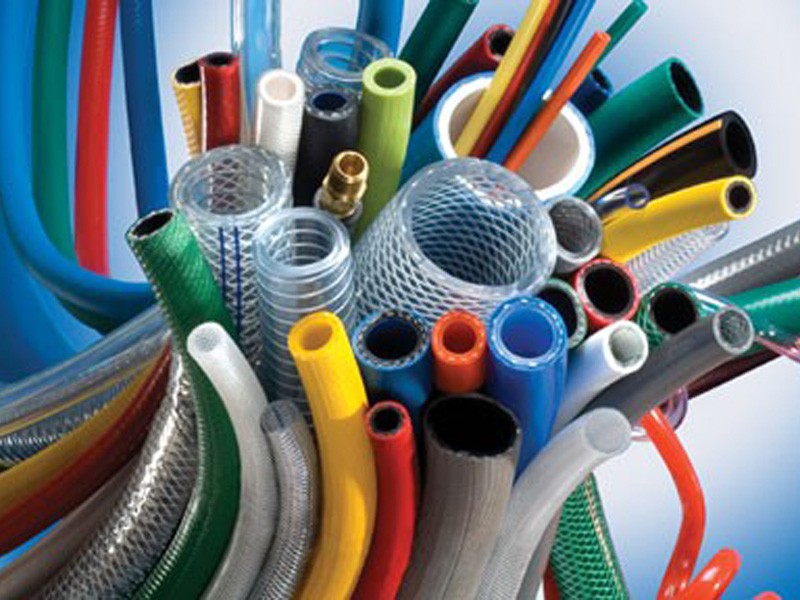Numerous standards exist for hydraulic hose production and use. Industry connection specifications and hose material are governed by standards, as well as guiding installation operations. Therefore, we will discuss hydraulic hose applications.
Hydraulic Hose Applications
Hydraulic Hose Construction Basics
There are three layers in the basic hydraulic hose construction. Each layer helps maintain a consistent and reliable flow of liquid while also protecting the overall assembly from breaking down as a result of wear or abrasion. These layers include the following:
- The inner tube is compatible with the liquid it carries. This allows both free-flowing elasticity and pressure-resistant stress bearing. This tube usually consists of PDFE (PTFE), thermoplastic or synthetic rubbers.
- The reinforcement layer surrounds the inner tube and consists of a coiled or braided wire, which supports the tubing while also protecting against tears.
- The outer layer consists of rigid materials and protects the innards of the hose.
Types of Hydraulic Hose Construction
There are a variety of hydraulic hose applications which are subject to a range of chemicals and pressures. Therefore, there are likewise a number of hydraulic hose construction. Types of hydraulic hose construction include the following:
- Reinforced. While this type of hosing resembles the basic three-layer construction, it has extra buffers in the in the reinforcement layer, most often in the form of textile braid, wire braid or wire helix material around the inner tube.
- Coiled. Coiled hoses are semi-rigid hoses. They are for expansion and easy story. The coiling allows the hose to stretch in such a way that does not put unnecessary pressure on the hose materials.
- Corrugated. Introduction corrugation is another method of increasing expansion and flexibility in a hose. This manifests as small threads or folds in the material of a hose, somewhat like an accordion, which allows the hose to expand and compress without damaging the housing.
- Articulated. Articulated hoses are sectional hoses, with connection of rigid shafts by flexible joints. Hoses can turn corners or swivel around other components with articulation.
- Multi-Element. Hoses that involve multiple elements listed above are termed as “multi-element hoses.”
Hydraulic Hose Compatibility
Liquids
The three main kinds of liquid that will pass through a hydraulic hose include the following:
- Petroleum oil
- Synthetic oil
- Liquid with a high-water content
While the majority of hydraulic hoses are capable of transporting petroleum oil and liquids with high-water contents, synthetic oils require dedicated hose materials. Compatibility ratings are typically available from the manufacturer or from resource literature.
Temperature
Hydraulic hoses are exposed to two temperature concerns which include internal liquid temperature and external working temperature.
Performance in terms of both temperatures determines the rating for hoses, with a maximum and minimum functioning temperature rating. If you exceed these ratings, this can result in severely reduced working life or even failure. This is why it is pertinent to use a hose what a proper rating to both the liquid temperature and the environment temperature.
Pressure
Hydraulic hoses can withstand both an external and an internal pressure minimum and maximum. If you exceed either of these ratings, this can result in severely curtail hose performance.
Pressure ratings or recommendations for a particular type of hose are typically available from the manufacturer.
Application Types
With the above considerations about hose performance, it is also crucial to understand other application necessities for hydraulic hoses. Pipes and tubes are typically more rigid, so they can handle higher temperature or internal pressure in a given application. However, this increase in rigidity makes them much more difficult to use in a moving operation.
For example, a construction digger requires a hydraulic system to operate a digging tool, but the freedom of movement needed to operate the tool can place limitations on hydraulic connections. Torque, flexibility and elasticity in tool arm movement can be allowed by a hydraulic which is unavailable with tubes or pipes.
In addition, some hydraulic systems can benefit from combinations of pipes, tubes and hoses. While large vehicles such as airplanes require hydraulic systems to operate wing movements and landing gear, the complexity of vehicle geometry necessitates variation in the hydraulic system.
A rule of thumb generally used for hydraulic hose installation is to match the hosing to the machine contour, which means that a hose should follow machine geometry as much as possible. A hose that is hanging off a tool can snag or puncture because of the tool’s wider movement radius. Matching the hose to the tool or machinery allows an operator to not have to consider extra obstacles when using the equipment.
Selecting the Proper Hydraulic Hose
Hydraulic hose users have numerous temperature, size and pressure factors to consider when selecting a hose for an application. There is a helpful acronym to track all of these considerations—STAMP. STAMP stands for Size, Temperature, Application, Material and Pressure. This acronym can be further discussed in our article: Selecting the Proper Hydraulic Hose for Your Application.
These are just a few important aspects to know when it comes to hydraulic hose applications. Contact Bryan Hose with the link below for more information!


Debra Wilson liked this on Facebook.
Charity Wilson liked this on Facebook.
Bryan Hose & Gasket liked this on Facebook.